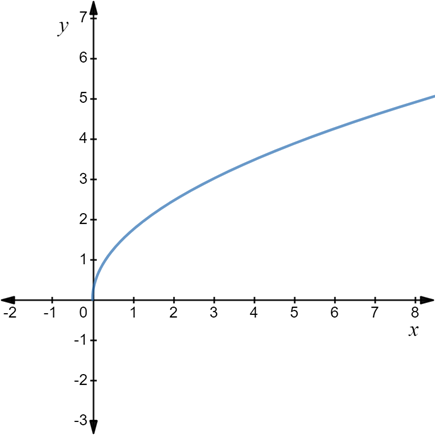
(a)
In Exercises 21−46,
(a) Identify the parent function
(b) Describe the sequence of transformations from
(c) Sketch the graph of
(d) Use function notation to write
29.
Identify the parent function
(a)
Answer to Problem 29E
The Parent function is
Explanation of Solution
Given:
Concept Used:
A Parent function is the function in the simplest form possible for a given family of functions that tends to preserve the properties and definition of the entire family.
Conclusion:
The Parent function is
(b)
Describe the sequence of transformations from
(b)
Answer to Problem 29E
The shape of
Explanation of Solution
Given:
Concept Used:
The sequence of transformations from
Conclusion:
The shape of
(c)
Sketch the graph of
(c)
Answer to Problem 29E

Explanation of Solution
Given:
Concept Used:
We used the sequence of transformations to the plot the above graph.
Conclusion:
We thus obtain the graph for
(d)
Use function notation to write
(d)
Answer to Problem 29E
Explanation of Solution
Given:
Conclusion:
Chapter 1 Solutions
Precalculus with Limits
- 7. [-/1 Points] DETAILS MY NOTES SESSCALCET2 6.1.505.XP. Evaluate the integral. (Use C for the constant of integration.) 21z³e² dz | 21 Need Help? Read It SUBMIT ANSWER 8. [-/1 Points] DETAILS MY NOTES SESSCALCET2 6.1.020. Evaluate the integral. 36 In y dy ₤36 25 Need Help? Read It SUBMIT ANSWER 9. [-/1 Points] DETAILS MY NOTES SESSCALCET2 6.1.009. Evaluate the integral. (Use C for the constant of integration.) In(7x In(7x + 1) dxarrow_forward10. [-/1 Points] DETAILS MY NOTES SESSCALCET2 6.1.506.XP. Evaluate the integral. √xy dy Need Help? Read It Watch It SUBMIT ANSWER 11. [-/1 Points] DETAILS MY NOTES SESSCALCET2 6.1.023. Evaluate the integral. 1/2 7 cos-1 x dx Need Help? Read It Watch It SUBMIT ANSWER 12. [-/1 Points] DETAILS MY NOTES SESSCALCET2 6.1.507.XP. Evaluate the integral. L² 0 (In x)² x3 dx Need Help? Read Itarrow_forwardi attached the question and the way i solved it, i believe i made an error, could you point it out for me because the correct answer is 3pi/2correct answer is D, please see both attached photosarrow_forward
- The position of a particle that moves along the x-axis is defined by x = - 3t^2 + 12^t - 6 f, where t is in seconds. For the time interval t = 0 to t = 3 s, (1) plot the position, velocity, and acceleration as functions of time; (2) calculate the distance traveled; and (3) determine the displacement of the particleshow the graph and write the solution with a penarrow_forwardThe position of a particle that moves along the x-axis is defined by x = - 3t^2 + 12^t - 6 f, where t is in seconds. For the time interval t = 0 to t = 3 s, (1) plot the position, velocity, and acceleration as functions of time; (2) calculate the distance traveled; and (3) determine the displacement of the particleshow the graph and write the solution with a penarrow_forwardThe answer for number 1 is D Could you show me whyarrow_forward
 Calculus: Early TranscendentalsCalculusISBN:9781285741550Author:James StewartPublisher:Cengage Learning
Calculus: Early TranscendentalsCalculusISBN:9781285741550Author:James StewartPublisher:Cengage Learning Thomas' Calculus (14th Edition)CalculusISBN:9780134438986Author:Joel R. Hass, Christopher E. Heil, Maurice D. WeirPublisher:PEARSON
Thomas' Calculus (14th Edition)CalculusISBN:9780134438986Author:Joel R. Hass, Christopher E. Heil, Maurice D. WeirPublisher:PEARSON Calculus: Early Transcendentals (3rd Edition)CalculusISBN:9780134763644Author:William L. Briggs, Lyle Cochran, Bernard Gillett, Eric SchulzPublisher:PEARSON
Calculus: Early Transcendentals (3rd Edition)CalculusISBN:9780134763644Author:William L. Briggs, Lyle Cochran, Bernard Gillett, Eric SchulzPublisher:PEARSON Calculus: Early TranscendentalsCalculusISBN:9781319050740Author:Jon Rogawski, Colin Adams, Robert FranzosaPublisher:W. H. Freeman
Calculus: Early TranscendentalsCalculusISBN:9781319050740Author:Jon Rogawski, Colin Adams, Robert FranzosaPublisher:W. H. Freeman
 Calculus: Early Transcendental FunctionsCalculusISBN:9781337552516Author:Ron Larson, Bruce H. EdwardsPublisher:Cengage Learning
Calculus: Early Transcendental FunctionsCalculusISBN:9781337552516Author:Ron Larson, Bruce H. EdwardsPublisher:Cengage Learning





